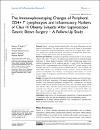The Immunophenotyping Changes of Peripheral CD4+ T Lymphocytes and Inflammatory Markers of Class III Obesity Subjects After Laparoscopic Gastric Sleeve Surgery - A Follow-Up Study
| Author | Rizk, Nasser M |
| Author | Fadel, Amina |
| Author | AlShammari, Wasaif |
| Author | Younes, Noura |
| Author | Bashah, Moataz |
| Available date | 2021-05-27T09:01:58Z |
| Publication Date | 2021-05-14 |
| Publication Name | Journal of Inflammation Research |
| Identifier | http://dx.doi.org/10.2147/JIR.S282189 |
| Citation | Rizk NM, Fadel A, AlShammari W, Younes N, Bashah M. The Immunophenotyping Changes of Peripheral CD4+ T Lymphocytes and Inflammatory Markers of Class III Obesity Subjects After Laparoscopic Gastric Sleeve Surgery – A Follow-Up Study. J Inflamm Res. 2021;14:1743-1757 https://doi.org/10.2147/JIR.S282189 |
| Abstract | Obesity is a chronic disorder characterized by a low-grade inflammatory state and immune cell irregularities. The study aimed to follow up on the changes in the peripheral CD4+ T lymphocytes and the pro-inflammatory cytokines; IL-6, TNF-alpha, MCP-1, and IL-10 at baseline and 12 weeks post-surgical intervention by the laparoscopic gastric sleeve (LGS) in morbidly obese patients (class III obesity subjects). A prospective longitudinal research included 24 class III obesity subjects with a BMI > 40 kg/m. The subjects were enrolled from the Metabolic/Surgical Department at Hamad Medical Corporation (HMC)-Qatar. Fasting blood samples were collected at admission to LGS for weight loss and after 12 weeks of LGS. The immunophenotype of CD4+ T-cell populations; naïve (CD45RAand CD27), central memory T cells (CD45RO and CD27), and effector memory (CD45ROand CD27) and T-regulatory cell (CD4+CD25+ FoxP3+) were identified using flow cytometry. Plasma pro-inflammatory cytokines and adipokines were evaluated. A control group of lean subjects was used to compare changes of T-regulatory and inflammatory biomarkers with postoperative changes in obese patients. The means (SD) of age and BMI of class III obesity subjects was 32.32 (8.36) years and 49.02 (6.28) kg/m respectively. LGS caused a significant reduction in BMI by 32%, p<0.0001. LGS intervention significantly decreased CD4+ T-lymphocytes and effector memory (TEM) cells but increased T-regulatory (Treg), naïve, and central memory (TCM) cells, with all values < 0.05. The increase of Treg cells postoperative is significantly lower compared to lean subjects, p < 0.05. A significant reduction of plasma IL-6, TNF-α, and MCP-1, but IL-10 significantly increased after LGS, with all <0.05. Adiponectin/leptin ratio improved after LGS by 2.9 folds, <0.0001. Weight loss by LGS accomplished a substantial rise of Treg and decreased EM T-lymphocytes with a shift from pro-inflammatory to the anti-inflammatory pattern. |
| Sponsor | QNRF |
| Language | en |
| Publisher | Dovepress |
| Subject | class III obesity immunity peripheral CD4+ T-lymphocytes T-regulatory cells follow up laparoscope gastric sleeve surgery |
| Type | Article |
| Pagination | 1743-1757 |
| Volume Number | 14 |
Files in this item
This item appears in the following Collection(s)
-
Biomedical Research Center Research [838 items ]
-
Biomedical Sciences [847 items ]


